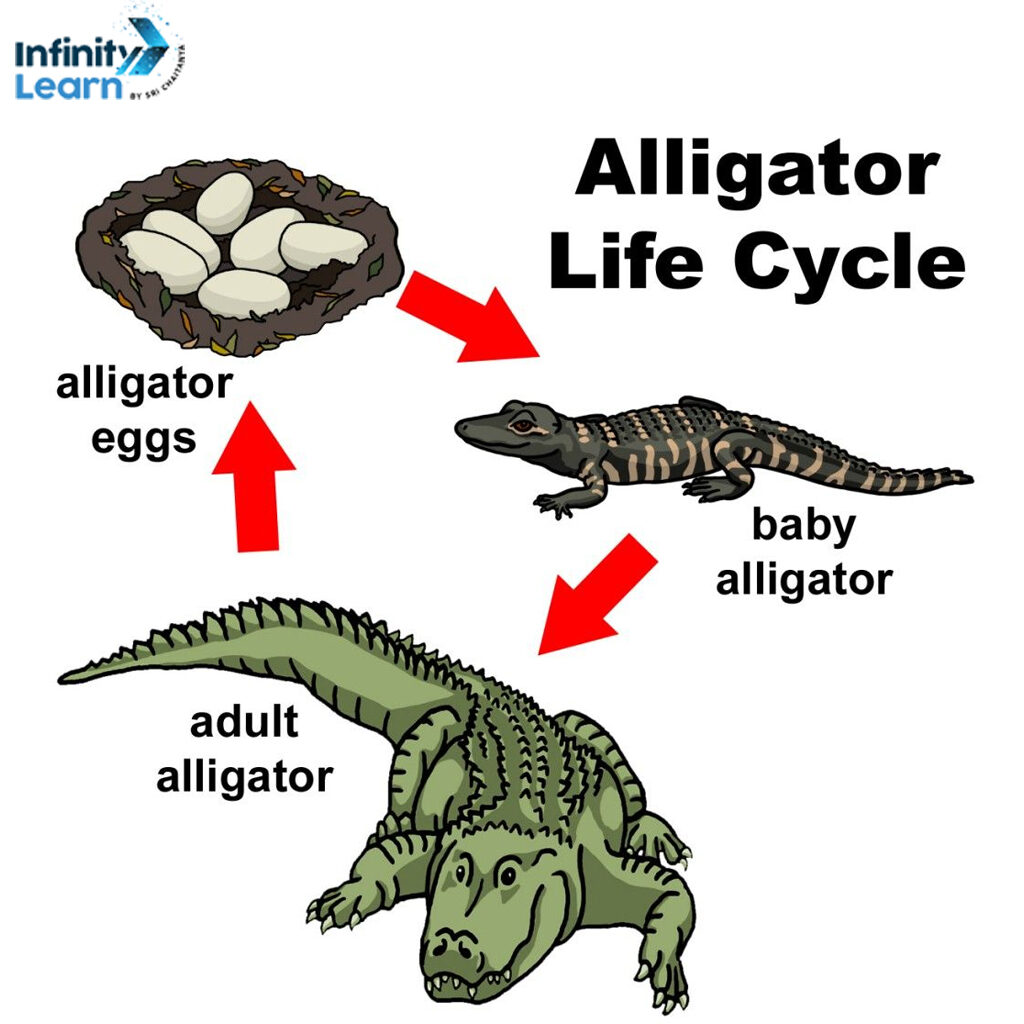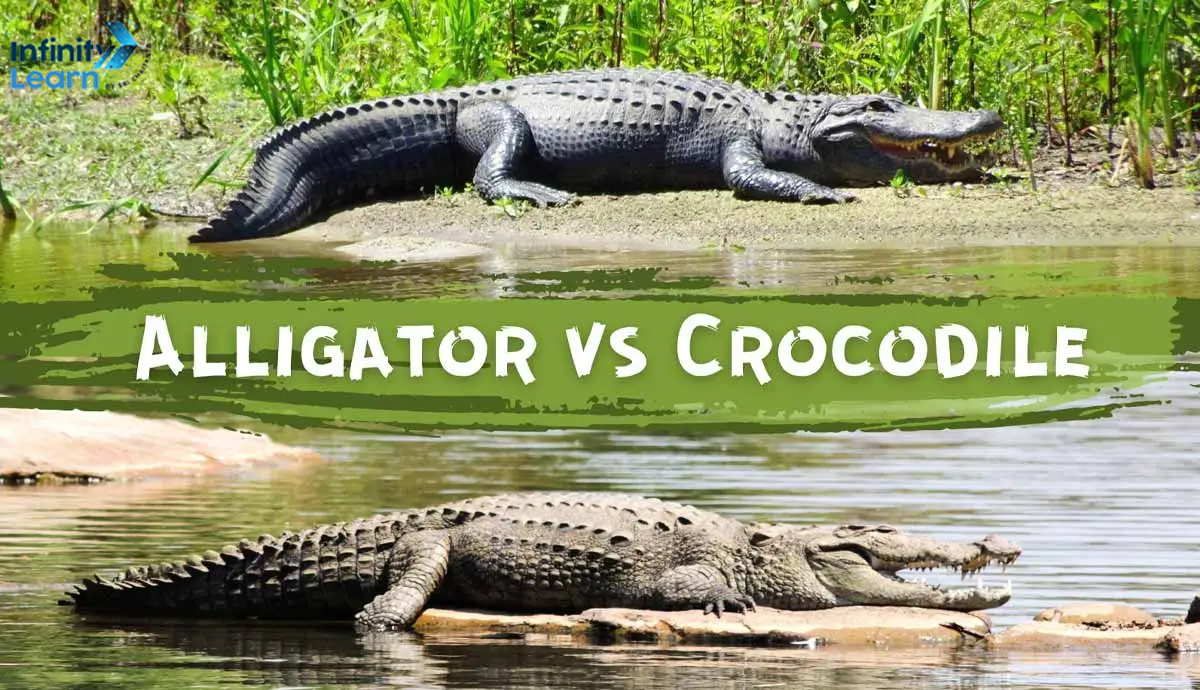Table of Contents
What is Alligator?
An alligator is a large, predatory reptile that is related to the crocodile. They are found in the United States, Central America, South America and Africa. Alligators are carnivores and their diet consists of fish, turtles, small mammals and birds. They are capable of running quickly on their short legs and of swimming powerfully with their long tails. Alligators can grow up to 14 feet long and weigh up to 1,000 pounds.
Evolution of Alligator
A 2016 study found that American alligators have hardly evolved over the last 8 million years, indicating they are very ancient. These alligators, part of the Alligatoridae family which also includes the Chinese alligator, first appeared about 37 million years ago. The name “alligator” comes from the Spanish “el lagarto,” meaning “the lizard,” used by early Spanish explorers in Florida. Alligators are large, tough-skinned reptiles with a U-shaped snout and an overbite, mainly active at night and eat meat, including fish, frogs, and mammals.

Characteristics of Alligator
Below are the characteristics of Alligator:
Physical Appearance
- Alligators have a long, round nose with nostrils on top so they can breathe when underwater.
- Their skin is tough and has hard, bony parts called scutes.
- They have four short legs. The front legs have five toes, and the back legs have four toes.
- Baby alligators have yellow stripes on their tails, but grown-ups have dark stripes.
Size
- Male alligators are bigger than females. Adult females are usually about 8.2 feet long, and males are about 11.2 feet long.
- The biggest males can weigh as much as 1,000 pounds.
Habitat
- Alligators live in places with fresh water like rivers, swamps, marshes, and lakes.
- They can’t stay in saltwater for long because they don’t have salt glands.
Diet
- Alligators eat meat and have strong jaws to break hard shells, like those of turtles.
- They eat fish, snails, birds, frogs, and mammals near the water.
- They catch their food with sharp teeth, eat small animals whole, or break big ones into smaller pieces.
Behavior
- Alligators are mostly active at night.
- During the day, they like to sunbathe by the water. At night, they go into the water and stay alone, each in its own area.
- They make hissing and roaring noises to talk to each other.
Reproduction
- Alligators lay eggs after mating in shallow water.
- The mom makes a nest and looks after the eggs until they hatch in two to three months.
- A nest can have 30 to 70 eggs, depending on the mom’s size and age.
- The eggs get warm from the sun and rotting plants put on them by the mom. The warmth decides if the baby will be a boy or girl alligator.
Habitat and Range of Alligator
Alligators live in different places depending on where they’re from. The American alligator mainly hangs out in the southeastern United States, like Florida, Louisiana, Georgia, and Texas. They like to live in places with lots of freshwater, like swamps, rivers, lakes, and marshes. These spots give them enough food and space to live comfortably and do things like basking in the sun, making nests, and hunting.
But the Chinese alligator has a smaller area where it lives, mostly in a few places in Eastern China. They like slow-moving rivers and streams and the nearby marshes and ponds. Sadly, the Chinese alligator’s homes are in trouble because of farming and development, which puts the species in danger of disappearing.
Life Cycle of Alligator
The life cycle of an alligator has several stages, each with its own special features. Let’s take a look:

- Egg Stage: Mother alligators lay eggs, usually around 20 to 50, in a nest made of mud, sticks, and plants near ponds or marshes. The temperature of the nest decides if the babies will be male or female.
- Juvenile Stage: The eggs hatch in June or July, and the baby alligators are carried to water by their mother. She protects them for about a year. A group of baby alligators with their mother is called a pod. They stay in the pod until they’re about four feet long, which can take one to three years.
- Adolescent Stage: Young alligators learn to eat small animals near water like insects, birds, and small fish. They stick close to their mother for protection for at least a year and can stay with her for up to three years. Once they reach four feet in length, they’re considered very safe in the wild.
- Adulthood and Mating: After being with their mother for up to three years, young alligators seek their own territory. When it gets warm, usually from mid-April to May, they start looking for mates. Males make sounds and vibrations in the water to attract females. Females mate with multiple males, so one clutch of eggs can have different fathers.
- Reproductive Years: When alligators are old enough, they mate in the spring. The female chooses her mate, they mate, and then she builds a nest. The male doesn’t help raise the young. Alligators repeat this mating process every year. In the wild, they can live from 35 to 50 years.
Anatomy of Alligator

Heart
Alligators have a four-chambered heart, just like birds and mammals. This special heart helps them breathe better and stay underwater longer. Even when it gets very cold or hot, their hearts keep beating.
Tail
The tail of an alligator is a strong tool for swimming and defending itself. It’s half of their body and helps them move through water smoothly. Alligator tails are powerful and can be used to fight off enemies.
Eyes
Alligators have eyes on the tops of their heads, so they can see prey even when they’re underwater. Their eyes reflect light, which helps them see in the dark. When you shine a light on them, their eyes glow red.
Teeth
Alligators have about 75 teeth at once, and they can grow up to 3,000 teeth in their lifetime. Their teeth are always being replaced and are really strong. When they bite, it’s as powerful as 3,000 pounds per inch!
Blood
Alligator blood has special properties that protect them from getting sick. It can fight off infections and viruses, like HIV-1 and Herpes simplex.
Difference Between Alligator and Crocodile

Alligators and crocodiles are big reptiles in the Crocodylia group, but they have several differences in their anatomy and behavior. Here are some key difference between alligator and crocodile
| Characteristic | Alligator | Crocodile |
|---|---|---|
| Snout Shape | Broad, U-shaped | Narrow, V-shaped |
| Teeth | Overbite (lower teeth not visible when mouth is closed) | Visible fourth tooth in lower jaw when mouth is closed |
| Color | Gray or black | Olive or tan |
| Habitat | Freshwater, such as swamps, marshes, and rivers | Saltwater, such as estuaries and mangrove swamps |
| Behavior | Tend to be less aggressive and avoid humans | Tend to be more aggressive and may attack humans more frequently |
Conservation Status of Alligator
- Endangered Status: American alligator was classified as endangered in 1967. This was before the Endangered Species Act of 1973 came into effect.
- Recovery: Thanks to conservation efforts, especially through the Endangered Species Act, the American alligator made a strong comeback in many areas where its numbers had dwindled. Consequently, it was taken off the endangered list in 1987 because it had fully recovered.
- Current Status: Today, the American alligator is considered to be of “Least Concern” according to the International Union for Conservation of Nature (IUCN) Red List.
- Threats: The main danger facing the American alligator nowadays is the loss of its habitat due to activities like draining wetlands and building on them. Human development often leads to the destruction and deterioration of the places where these alligators live.
- Conservation and Management: The American alligator is under federal protection as a threatened species according to the Endangered Species Act. This is because it looks similar to the American crocodile. Additionally, it’s also designated as a threatened species under Florida’s Endangered and Threatened Species Rule.
Facts About Alligator
Alligators vs. Crocodiles: Alligators and crocodiles might seem similar, but you can tell them apart. Alligators have wider, U-shaped snouts, and when they close their mouths, you only see their upper teeth. Crocodiles, however, have V-shaped snouts, and both upper and lower teeth show when their mouths are shut.
Alligator Sleeping Habits: Alligators don’t hibernate like some animals, but they do enter a sleepy state called brumation in cold months. They become less active and might hang out in burrows near water.
Alligator’s Strong Stomach: Alligators have powerful stomachs that can break down tough stuff like bones and horns, which is pretty unusual in the animal kingdom. This helps them get all the nutrients from their food and creates less waste.
Alligator Talk: Alligators make a bunch of different sounds to talk to each other. They can growl, hiss, and even make a sound like a cough. They use these sounds to find mates, show off their territory, and call for help if they’re in trouble. Baby alligators even make noise before they hatch to tell their mom it’s time to come out.
Temperature and Baby Alligators: Whether a baby alligator becomes a boy or a girl depends on how warm it was when they were eggs. If it was really hot, they’re more likely to be boys. If it was cooler, they’ll probably be girls. If it was in-between, there might be a mix of boys and girls.
Alligator Farms: Alligators are farmed in places like Louisiana and Florida for their skin and meat. Their skin is used to make fancy leather stuff, and their meat is considered a tasty treat. Farming helps protect wild alligators by lowering the need to hunt them.
Ancient Alligators: Alligators have been around for millions of years and haven’t changed much. They’ve survived a lot of big changes in the world and have adapted to different environments over time.
Alligator Tears: Alligators, like crocodiles, produce tears, but not because they’re sad. These tears help clean their eyes and get rid of extra salt from their bodies.
Strong Bites: Alligators have one of the strongest bite forces in the animal kingdom. Their bite can be really powerful, enough to crush their food easily.
FAQs on Alligator
Are alligators loyal?
Alligators are not loyal in the way pets like dogs are. They are wild animals that act on instinct and survival needs rather than forming loyal bonds with others or humans.
Are alligators attracted to blood?
Alligators are not specifically attracted to blood like some predators are. They rely on their keen sense of smell and sight to find food, responding more to the movements of potential prey rather than the scent of blood.
Do alligators lay eggs?
Yes, alligators lay eggs. Female alligators build nests and lay anywhere from 20 to 50 eggs, which they guard fiercely until the eggs hatch about 60 to 65 days later.
What do alligators eat?
Alligators are carnivores and eat a variety of food, including fish, birds, turtles, and mammals. They are opportunistic feeders and will eat almost anything they can catch.
Is alligator powerful or crocodile?
Both alligators and crocodiles are powerful, but crocodiles generally have a stronger bite force and are more aggressive. However, alligators are still incredibly strong and capable predators.
What is the difference between alligator and crocodile?
The main difference between an alligator and a crocodile is their snout shape and teeth visibility. Alligators have a wider, U-shaped snout, and when their mouths are closed, only their upper teeth show. Crocodiles have a narrower, V-shaped snout, and both their upper and lower teeth are visible when their mouths are closed.









